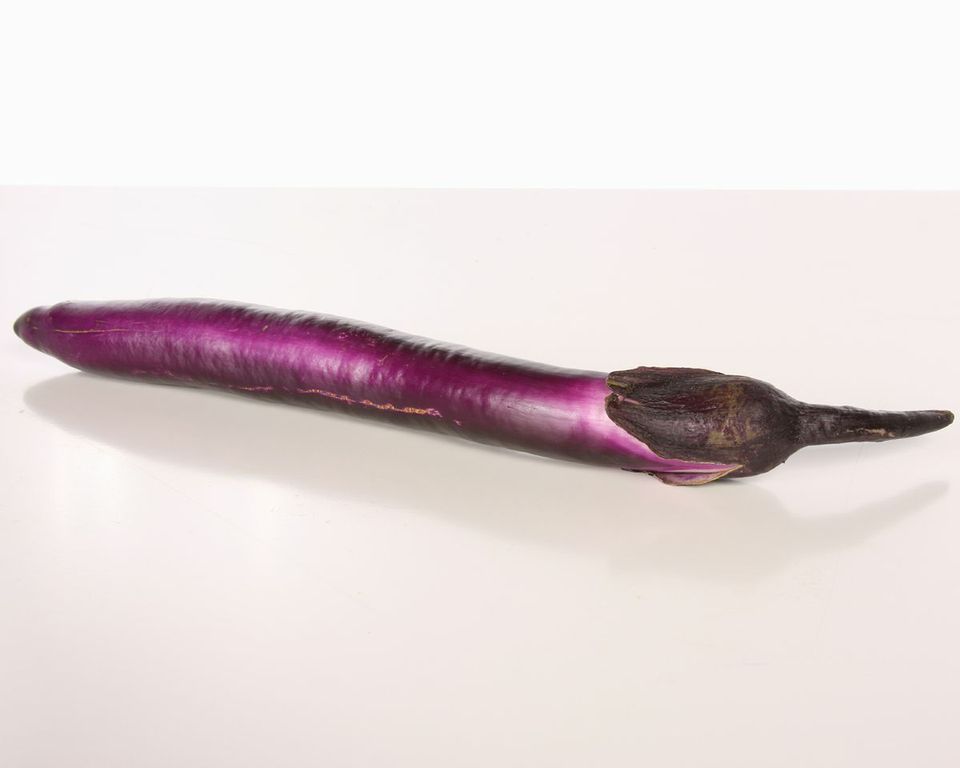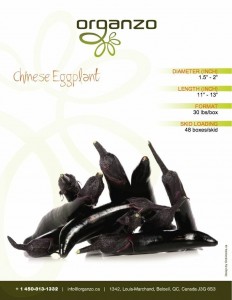Chinese eggplant
Introduction
Chinese eggplant is one of the longest varieties of eggplants. A Chinese eggplant is long and thin and its shape resembles a cucumber. Its purplish-blue skin (or pinkish for certain varieties) is shiny, smooth and very thin. Its dense and consistent flesh is creamy white and has many small seeds. It has an excellent sweet flavour with woody notes and no bitterness.
Chinese eggplant is picked prior to its physiological maturity, when it reaches 12-15 cm in length and has a bright colour, before the seeds become hard and when the flesh is not bitter. Any “crooked” (climatic stress suffered by the plant) eggplants are not appreciated by our clients so we do not display these for sale. We take all the necessary precautions to handle them with care as the skin of this variety of eggplant is very prone to bruising when knocked.
Eggplant is rich in zinc, potassium and magnesium, while it is low in energy and calories, is a diuretic and astringent and is very rich in soluble fibres, which are easy to digest when steamed or stewed.
You need to know:
-
It is better to cook Chinese eggplant without peeling it, mainly because of its very fragile consistency but also because its skin is rich in antioxidants (vitamins C and E, selenium and carotenoids which protect the cells from free radicals) and nutrient matter.
- Eggplant can be an allergenic for people who are allergic to pollen from grassy plants.
Organzo: a strategic and authentic partnership between truck farmers and our agronomic services department, from seed to harvest.
We constantly suggest new varieties to improve product qualityand options for seeds that are less prone to ravagers, diseases and physiological disorders.
We walk through the producers’ fields every week looking at and inspecting the slightest defaults in plants, in order to delay any outbreak of ravagers and/or diseases by applying good agricultural practices, and when needed, by rationally using registered pesticides.
Selection and preservation
Choose a very fresh eggplant that has shiny, tight, brightly coloured skin with no bruises or brown marks (they could be hiding soft and bitter flesh) and with a green flower stalk. Visible signs of water loss include diminished exterior shine, wilting of the skin, spongy flesh and browning of the calyx.
The eggplant keeps in a perforated bag in the fridge for up to a week.
When kept for too long, it becomes dull, its skin wrinkles and, above all, the flesh softens and becomes hard to digest.
Cooking instructions
To prepare an eggplant, clean it under running water, cut the top off to remove the flower stem then cut into slices or cubes.
We can cook it in a wok (sautéed at high heat), on the BBQ, in curries, soups, eggplant dip…
You need to know:
-
It is eaten before it ripens (when ripe, the flesh becomes fibrous and the seeds are brown and hard).
-
Raw, the eggplant is bland, bitter and spongy, but its qualities develop when cooked. Upon cooking, its aromas are released and it is impregnated with the flavours of the dish. Its flesh becomes soft and fluffy. It is always eaten cooked, steamed, grilled, baked or pan-seared.
-
It turns black on contact with the air (lemon juice can prevent this)
-
It is a real sponge for oil: avoid drowing it in oil.
-
To keep its beautiful purple colour on your plate, dip your eggplant cubes quickly into hot frying oil before you sautee them.


